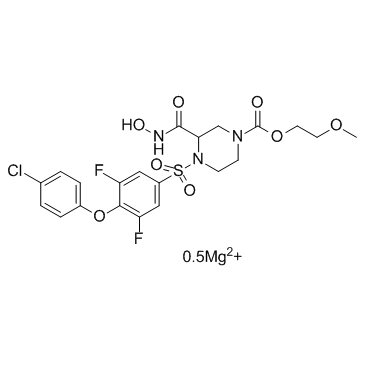1224964-36-6
| Name | 2-methoxyethyl 4-((4-(4-chlorophenoxy)-3,5-difluorophenyl)sulfonyl)-3-(hydroxycarbamoyl)piperazine-1-carboxylate |
|---|
| Description | XL-784 is a selective matrix metalloproteinases (MMP) inhibitor, with IC50s of ~1900, 0.81, 120, 10.8, 18, 0.56 nM for MMP-1,MMP-2,MMP-3,MMP-8,MMP-9,MMP-13,respectively. |
|---|---|
| Related Catalog | |
| Target |
MMP-1:1900 nM (IC50) MMP-2:0.81 nM (IC50) MMP-3:120 nM (IC50) MMP-8:10.8 nM (IC50) MMP-9:18 nM (IC50) MMP13:0.56 nM (IC50) |
| In Vitro | XL-784 is a highly potent, low-molecular-weight (1,122 g/mol) inhibitor of MMPs that has very limited aqueous solubility (20 μg/mL). XL-784 potently inhibits MMP-2, MMP-13, andADAM10 [TNF-α-converting enzyme (TACE)] activity in vitro, with IC50 values in the range of 1-2 nM. XL-784 also inhibits MMP-9 (IC50 ~20 nM) activity and ADAM17 (IC50 ~70 nM) also known as TACE. However, it exhibits low potency for inhibition of MMP-1 (IC50 ~2,000 nM)[1]. |
| In Vivo | All mice tolerate the treatments similarly. Control mice all developed aneurysms with a mean %△AD of 158.5%±4.3%. Treatment with all doses of XL-784 and doxycycline are effective in inhibiting aortic dilatation. There is a clear dose-response relationship between XL-784 and reductions in aortic dilatation at harvest (50 mg/kg 140.4% ±3.2%; 125 mg/kg 129.3% ±5.1%; 250 mg/kg 119.2%±3.5%; all Ps<0.01 compared to control). This continues with the higher doses (375 mg/kg 88.6%±4.4%; 500 mg/kg 76.0%±3.5%). The highest 2 doses of XL-784 tested are more effective than doxycycline (112.2%±2.0%, P<0.05) in inhibiting maximal dilatation of the aorta after elastase perfusion[2]. |
| Animal Admin | Mice[2] A total of 89 mice undergo aortic perfusion. Beginning the day of perfusion, animals are treated with the study drug (e.g., XL-784), a negative control, or doxycycline. 76 animals survive to sacrifice and are included in the analysis. Animals treated with the experimental agent, XL-784, receive gavage daily with the agent diluted in 0.1 mL of Cremophor, a nonionic castor oil-based solubilizer and emulsifying agent. Three doses of the drug are used, 50 (n=17), 125 (n=17), and 250 mg/kg per d (n=18) administered as a single daily dose. The fifth group of mice do not receive a gavage treatment but are treated with doxycycline (n=19) in their drinking water at a concentration 100 mg/kg per d of the animals. In the second treatment protocol, a total of 50 animals underwent aortic perfusion and 47 animals survive for analysis at 14 days. The 5 treatment groups are XL-784 at 250, 375, or 500 mg/kg, Cremaphor diluent alone, or doxycycline 100 mg/kg. Animals are assigned in groups of 3 to a treatment group rotating randomly through each treatment group until there are 9 animals in each group except for the 500 mg/kg per d group which totaled to 14 animals[2]. |
| References |
| Molecular Formula | C21H22ClF2N3O8S |
|---|---|
| Molecular Weight | 549.9294864 |
